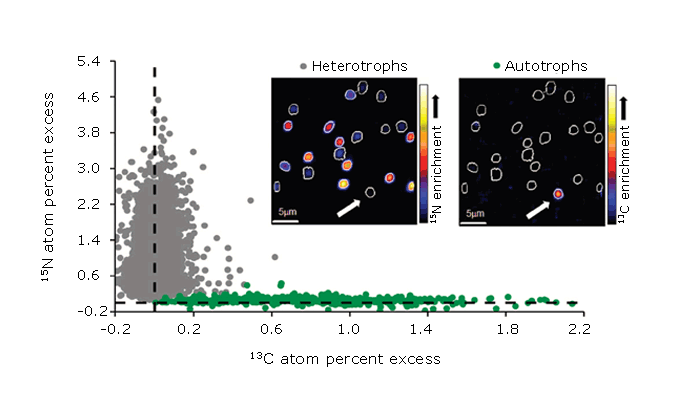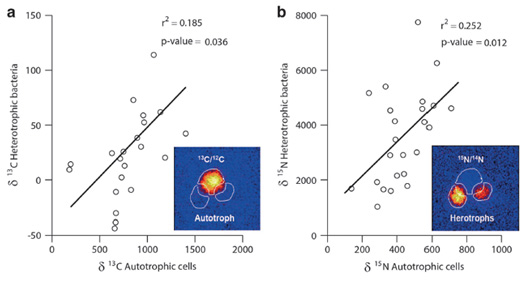Quantifying the contribution of marine microorganisms to carbon and nitrogen cycles and their response to predicted ocean warming is one of the main challenges of microbial oceanography. The authors of the present study investigated the effect of warming (4 °C over ambient) in a temperate ecosystem on the cell specific activities of marine heterotrophic* and autotrophic* cells and the corresponding transfer of C and N between single cells. Seawater samples were incubated at in situ and increased temperatures in the presence of stable isotope labeled substrates (13CO2 gas for autotrophs and 15N-leucine for heterotrophs). The NanoSIMS was used to quantify the C and N uptake by free-living cells as well as phytoplankton-bacteria consortia, defined here as bacteria physically attached to phytoplankton.

Above: Comparison between 13C and 15N isotopic enrichment for all analyzed microbial cells incubated with 13C bicarbonate and 15N leucine (dashed lines = isotope natural abundances). Each dot represents one cell, with enrichment obtained from integrating pixels of defined region of interest in the NanoSIMS images. NanoSIMS enrichment images showing identified heterotrophs (left) and one autotroph (right, identified by the arrow).
Below: Zoom on one phytoplankton-bacteria consortium ( = physically attached) of the warm incubation.
(a) Positive correlation between the 13C incorporation rates of phytoplankton cells and those of their attached bacterial cells, (b) Similar positive correlation between the 15N incorporation rates of bacteria and those of the phytoplankton cells to which they were attached.
Image: two heterotrophic bacteria attached to a picophytoplankton cell.

Results: Elevated temperature increased total C fixation by over 50%, a small but significant fraction of which was transferred to heterotrophs within 12 h. Cell-to-cell attachment doubled the secondary C uptake by heterotrophic bacteria and increased secondary N incorporation by autotrophs by 68%. Warming also increased the abundance of phytoplankton with attached heterotrophs by 80%, and promoted C transfer from phytoplankton to bacteria by 17% and N transfer from bacteria to phytoplankton by 50%.
The results of the study indicate that phytoplankton-bacteria ATTACHMENT provides an ECOLOGICAL ADVANTAGE for nutrient incorporation, suggesting a MUTUALISTIC RELATIONSHIP that appears to be ENHANCED BY TEMPERATURE INCREASES.
From: Elevated temperature increases carbon and nitrogen fluxes between phytoplankton and heterotrophic bacteria through physical attachment. Nestor Arandia-Gorostidi, Peter K Weber, Laura Alonso-Sáez, Xosé Anxelu G Morán and Xavier Mayali. The ISME Journal (2016), 1–10.
* Basic lexicon:
- Autotroph: organism producing complex organic compounds from inorganic and mineral matter present in its surroundings, generally using energy from light (photosynthesis) or inorganic chemical reactions. Ex: plants, algae, cyanobacteria, sulfur-reducing bacteria...
- Heterotroph: organism using organic carbon for growth, not able to fix carbon from inorganic sources (such as carbon dioxide). Ex: animals, fungi, bacteria,…